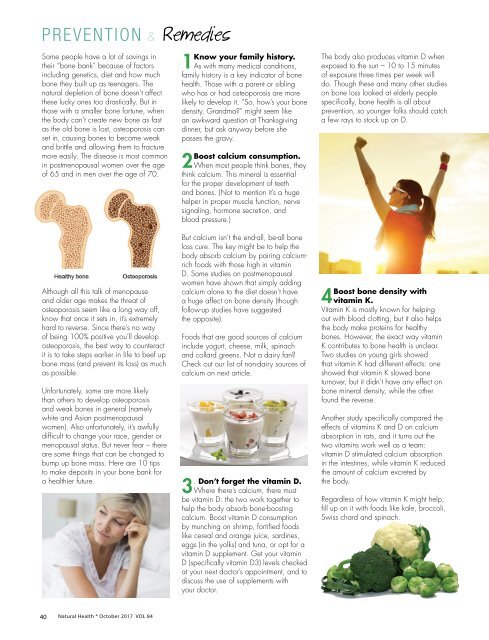Natural Health October 2017
Create successful ePaper yourself
Turn your PDF publications into a flip-book with our unique Google optimized e-Paper software.
PREVENTION & Remedies<br />
Some people have a lot of savings in<br />
their “bone bank” because of factors<br />
including genetics, diet and how much<br />
bone they built up as teenagers. The<br />
natural depletion of bone doesn’t affect<br />
these lucky ones too drastically. But in<br />
those with a smaller bone fortune, when<br />
the body can’t create new bone as fast<br />
as the old bone is lost, osteoporosis can<br />
set in, causing bones to become weak<br />
and brittle and allowing them to fracture<br />
more easily. The disease is most common<br />
in postmenopausal women over the age<br />
of 65 and in men over the age of 70.<br />
1Know your family history.<br />
As with many medical conditions,<br />
family history is a key indicator of bone<br />
health. Those with a parent or sibling<br />
who has or had osteoporosis are more<br />
likely to develop it. “So, how’s your bone<br />
density, Grandma?” might seem like<br />
an awkward question at Thanksgiving<br />
dinner, but ask anyway before she<br />
passes the gravy.<br />
2Boost calcium consumption.<br />
When most people think bones, they<br />
think calcium. This mineral is essential<br />
for the proper development of teeth<br />
and bones. (Not to mention it’s a huge<br />
helper in proper muscle function, nerve<br />
signaling, hormone secretion, and<br />
blood pressure.)<br />
The body also produces vitamin D when<br />
exposed to the sun – 10 to 15 minutes<br />
of exposure three times per week will<br />
do. Though these and many other studies<br />
on bone loss looked at elderly people<br />
specifically, bone health is all about<br />
prevention, so younger folks should catch<br />
a few rays to stock up on D.<br />
Although all this talk of menopause<br />
and older age makes the threat of<br />
osteoporosis seem like a long way off,<br />
know that once it sets in, it’s extremely<br />
hard to reverse. Since there’s no way<br />
of being 100% positive you’ll develop<br />
osteoporosis, the best way to counteract<br />
it is to take steps earlier in life to beef up<br />
bone mass (and prevent its loss) as much<br />
as possible.<br />
Unfortunately, some are more likely<br />
than others to develop osteoporosis<br />
and weak bones in general (namely<br />
white and Asian postmenopausal<br />
women). Also unfortunately, it’s awfully<br />
difficult to change your race, gender or<br />
menopausal status. But never fear – there<br />
are some things that can be changed to<br />
bump up bone mass. Here are 10 tips<br />
to make deposits in your bone bank for<br />
a healthier future.<br />
But calcium isn’t the end-all, be-all bone<br />
loss cure. The key might be to help the<br />
body absorb calcium by pairing calciumrich<br />
foods with those high in vitamin<br />
D. Some studies on postmenopausal<br />
women have shown that simply adding<br />
calcium alone to the diet doesn’t have<br />
a huge affect on bone density (though<br />
follow-up studies have suggested<br />
the opposite).<br />
Foods that are good sources of calcium<br />
include yogurt, cheese, milk, spinach<br />
and collard greens. Not a dairy fan?<br />
Check out our list of non-dairy sources of<br />
calcium on next article.<br />
3<br />
. Don’t forget the vitamin D.<br />
Where there’s calcium, there must<br />
be vitamin D: the two work together to<br />
help the body absorb bone-boosting<br />
calcium. Boost vitamin D consumption<br />
by munching on shrimp, fortified foods<br />
like cereal and orange juice, sardines,<br />
eggs (in the yolks) and tuna, or opt for a<br />
vitamin D supplement. Get your vitamin<br />
D (specifically vitamin D3) levels checked<br />
at your next doctor’s appointment, and to<br />
discuss the use of supplements with<br />
your doctor.<br />
4Boost bone density with<br />
vitamin K.<br />
Vitamin K is mostly known for helping<br />
out with blood clotting, but it also helps<br />
the body make proteins for healthy<br />
bones. However, the exact way vitamin<br />
K contributes to bone health is unclear.<br />
Two studies on young girls showed<br />
that vitamin K had different effects: one<br />
showed that vitamin K slowed bone<br />
turnover, but it didn’t have any effect on<br />
bone mineral density, while the other<br />
found the reverse.<br />
Another study specifically compared the<br />
effects of vitamins K and D on calcium<br />
absorption in rats, and it turns out the<br />
two vitamins work well as a team:<br />
vitamin D stimulated calcium absorption<br />
in the intestines, while vitamin K reduced<br />
the amount of calcium excreted by<br />
the body.<br />
Regardless of how vitamin K might help,<br />
fill up on it with foods like kale, broccoli,<br />
Swiss chard and spinach.<br />
40 <strong>Natural</strong> <strong>Health</strong> * <strong>October</strong> <strong>2017</strong> VOL 84

















